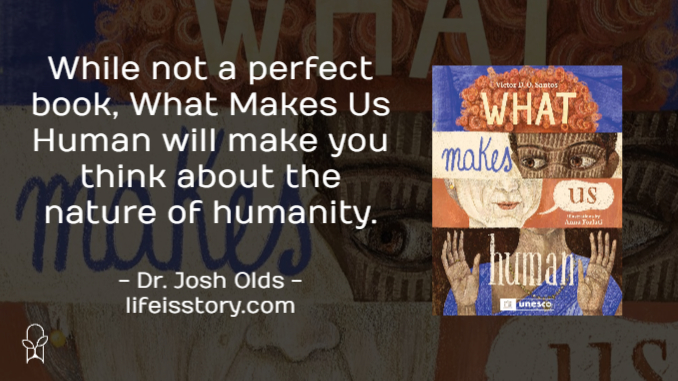
Published by Eerdmans Books for Young Readers on March 5, 2024
Genres: Children's, Children's Educational
Buy on Amazon
Goodreads

A poetic riddle about language, history, and culture, released in partnership with UNESCO in honor of the International Decade of Indigenous Languages (2022-2032).
Can you guess what I am? I have been around a very, very long time. You hardly knew me as a baby, but now you cannot get me out of your head. There are thousands of me, all over the globe, and some of those forms are disappearing. I can connect you to the past, present, and future. Who am I—and why am I so important to humanity?
Clever and thought-provoking, What Makes Us Human is an accessible introduction to how language connects people across the world. This unique book celebrates all the amazing ways communication shapes our lives, including through text messages on phones, Braille buttons in elevators, and endangered languages at risk of disappearing.
What Makes Us Human? At first this seems like a simple enough question, but ponder it long enough and that’s when things begin to get a bit tricky—particularly when speaking from a purely secular and anthropological viewpoint. In collaboration with UNESCO (United Nations Educational, Scientific and Cultural Organization), children’s author Victor D.O. Santos and artist Anna Forlati, make the argument that it is language that makes us uniquely human.
Santos, a children’s author with a Ph.D. in Linguistics is the perfect author to express this sentiment—able to understand language at a very deep level but also communicate that in a way that is accessible to young children. Forlati’s illustrations are an excellent complement and the array of languages portrayed in the book give her ample reason to portray an array of cultural backdrops. Together they show that although our specific languages are many and varied, they also bring us together.
What Makes Us Human? isn’t quite upfront about its answer, however. The book is portrayed like a riddle. “I can show you love. But also hurt you,” says one panel. “Some people have tried to avoid me. But they cannot get me out of the heads,” says another. The answer to the riddle is found in the illustrations. A jaggedy text bubble coming out of a radio accompanies “But also hurt you” and Forlati fills is with scenes of war. “I can show you love” is paired with an elderly woman with a soft and rounded text bubble filled with scenes of beauty as she speaks to her cat. It’s a clever and harmonious pairing that perhaps, implicitly, shows an understanding that language can even be non-verbal. And in case you miss it, the final panels make it obvious: “I make you human. I am language.”
In a lot of ways, I loved this book. The writing, the illustrations, the way the two tie together—it’s all vey beautiful. But what I kept coming back to was the question of whether or not language was really the answer. One panel, talking about the passage of time, says that babies learn language while the elderly may gradually forget. If language makes us human, are babies and the elderly less than human? What about those who struggle to communicate or lack the physical or mental ability to do so. Are they less than human? Defining humanity in terms of a physical/mental learned skill means that some who are human are going to be left out of the definition.
Moreover, What Makes Us Human focuses almost exclusively on the spoken word. Sign language is noticeably explicitly absent in the text, though it does show up at least once in an illustration. I saw no examples of AACC communication. There really needed to be more clear examples of non-traditional communication in the text. Lastly, Santos doesn’t seem to consider that many non-human animals have forms of language. Obviously, these language forms are different than our own but the truth remains that communication is inherent across all species.
What Makes Us Human falls into the trap of trying to define humanity by one natural thing. Even saying that language is *part* of what makes us human would avoid the problematic implications that book perhaps inadvertently gives. And maybe I’m digging too deep into semantics, but what better topic to nitpick semantics than a book about linguistics? This is still a good book and I would definitely use with an upper elementary school class, but I would also use this as a time to teach critical evaluation and examination. How could the author have been clearer? How could they have done better? Have they overstated their claim? If we problematize their claim, what issues arise? So while not a perfect book, What Makes Us Human is one that will make you think.
